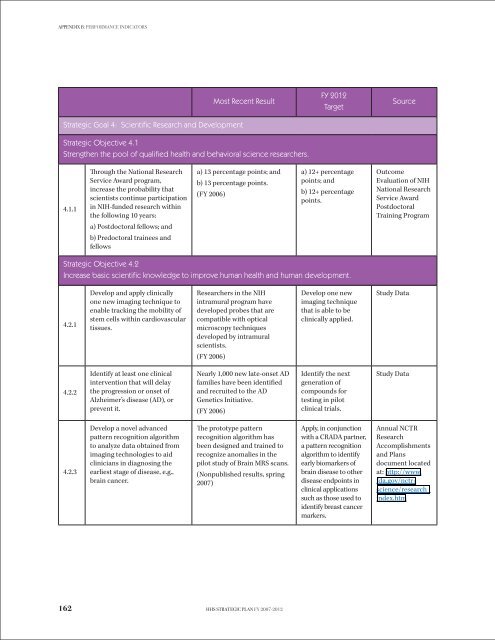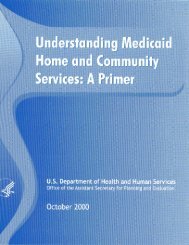STRATEGIC PLAN - ASPE - U.S. Department of Health and Human ...
STRATEGIC PLAN - ASPE - U.S. Department of Health and Human ...
STRATEGIC PLAN - ASPE - U.S. Department of Health and Human ...
Create successful ePaper yourself
Turn your PDF publications into a flip-book with our unique Google optimized e-Paper software.
Appendix b: performance indicatorsStrategic Goal 4: Scientific Research <strong>and</strong> DevelopmentMost Recent ResultStrategic Objective 4.1Strengthen the pool <strong>of</strong> qualified health <strong>and</strong> behavioral science researchers.FY 2012TargetSource4.1.1Through the National ResearchService Award program,increase the probability thatscientists continue participationin NIH-funded research withinthe following 10 years:a) Postdoctoral fellows; <strong>and</strong>b) Predoctoral trainees <strong>and</strong>fellowsa) 13 percentage points; <strong>and</strong>b) 13 percentage points.(FY 2006)a) 12+ percentagepoints; <strong>and</strong>b) 12+ percentagepoints.OutcomeEvaluation <strong>of</strong> NIHNational ResearchService AwardPostdoctoralTraining ProgramStrategic Objective 4.2Increase basic scientific knowledge to improve human health <strong>and</strong> human development.4.2.1Develop <strong>and</strong> apply clinicallyone new imaging technique toenable tracking the mobility <strong>of</strong>stem cells within cardiovasculartissues.Researchers in the NIHintramural program havedeveloped probes that arecompatible with opticalmicroscopy techniquesdeveloped by intramuralscientists.(FY 2006)Develop one newimaging techniquethat is able to beclinically applied.Study Data4.2.2Identify at least one clinicalintervention that will delaythe progression or onset <strong>of</strong>Alzheimer’s disease (AD), orprevent it.Nearly 1,000 new late-onset ADfamilies have been identified<strong>and</strong> recruited to the ADGenetics Initiative.(FY 2006)Identify the nextgeneration <strong>of</strong>compounds fortesting in pilotclinical trials.Study Data4.2.3Develop a novel advancedpattern recognition algorithmto analyze data obtained fromimaging technologies to aidclinicians in diagnosing theearliest stage <strong>of</strong> disease, e.g.,brain cancer.The prototype patternrecognition algorithm hasbeen designed <strong>and</strong> trained torecognize anomalies in thepilot study <strong>of</strong> Brain MRS scans.(Nonpublished results, spring2007)Apply, in conjunctionwith a CRADA partner,a pattern recognitionalgorithm to identifyearly biomarkers <strong>of</strong>brain disease to otherdisease endpoints inclinical applicationssuch as those used toidentify breast cancermarkers.Annual NCTRResearchAccomplishments<strong>and</strong> Plansdocument locatedat: http://www.fda.gov/nctr/science/research_index.htm162 HHS Strategic Plan FY 2007-2012
















